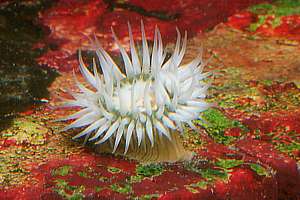Anthothoe albens
Description 1
Habitat
Column
Oral disc
Tentacles
Distribution
Edited version of Transactions and Proceedings of the Royal Society of New Zealand 1868-1961, Volume 41, 1908, p385
Art. XXXVI.—A Review of the New Zealand Actiniaria known to Science, together with a Description of Twelve New Species.
(by F. G. A. Stuckey)
Thoe albens (sp. nov.).
This species in expansion is opaque-white, but is so pulpy that in contraction it looks like a small shapeless mass of transparent jelly. This makes it difficult to kill well, and extremely difficult to make good histological preparations of the animal.
Pedal-disc.—Adherent to Lessonia, below low-water mark. The ectoderm and endoderm are thicker than the mesoglœa. The latter shows the fibrous structure characteristic of most actinians. It also contains a number of lacunæ. The nerve-layer of the ectoderm is very well developed. The disc spreads out a little beyond the column, the outspread portion being marked with golden-yellow radial lines.
Column.—Similar in structure to the pedal-disc, but thinner. It has the appearance of having a mesoglœal circular muscle throughout its whole height. It is smooth, with no suckers or verrucæ. Neither are there any visible cinclides except when the acontia are ejected. The colour is white.
Sphincter Muscle.—There is a spindle-shaped thickening of the mesogloea in the upper part of the column, causing a slight bulging of the wall. In the sphincter the muscle spaces are very close together, but otherwise this muscle is of the usual sagartian type.
Tentacles.—There are 96, in four cycles, 12 + 12 + 24 + 48 = 96. In colour they are opaque-white, like the column; in shape, conical and tapering. The length is rather more than half the diameter of the disc. At the base of each tentacle is an incomplete ring of yellow pigment, the open part directed inwards and the outer circumferences of the rings close together, so as to make an almost continuous ring of yellow round the top of the column under the tentacles (fig. 7). Nematocysts are numerous in the tentacles. The ectoderm and endoderm are relatively thick, the mesoglœa being reduced to a mere streak. The muscle-bearing processes on both sides are few in number. The nerve-layer is compact, and appears almost as a line in cross-sections. There are numerous large irregular spaces in the ectoderm.
Oral Disc.—Colour white, as in the tentacles and column. Mouth is set on a peristome. The stomodæum is white, and there are 2 siphonoglyphs.
Mesenteries. — Owing to the difficulty of killing and fixing this species I was unable to determine accurately the number and arrangement of the mesenteries.
Acontia: — These are emitted reluctantly, some through the mouth, others from cinclides which are placed on the column just under the yellow line at the bases of the tentacles. The acontia are long, and contain very large numbers of nematocysts, together with many nerve-cells. The processes of the nerve-cells run between the closely packed nematocysts (fig. 8).
Habits.—This species lives in the chinks among the “roots” of Lessonia. It is impatient of light.
Dimensions.—In full expansion it is 12 mm. high and 10 mm. in diameter. The pedal-disc is rather wider than the column.
Distribution.— Of the species—Island Bay.
References 1
Note any thumbnails in this section are only to indicate what that reference shows while this page is being built. They have not yet been verified, don't assume they are correct examples.
-
http://www.seafriends.org.nz/enviro/habitat/rscnida.htm

- Art. XXXVI.—A Review of the New Zealand Actiniaria known to Science, together with a Description of Twelve New Species, by F. G. A. Stuckey. http://rsnz.natlib.govt.nz/volume/rsnz_41/rsnz_41_00_005220.html page 385
Synonyms
- Actinothoe albens
- Thoe albens
- Thoe albida
Sources and Credits
- (c) Tony Wills, some rights reserved (CC BY-SA)


